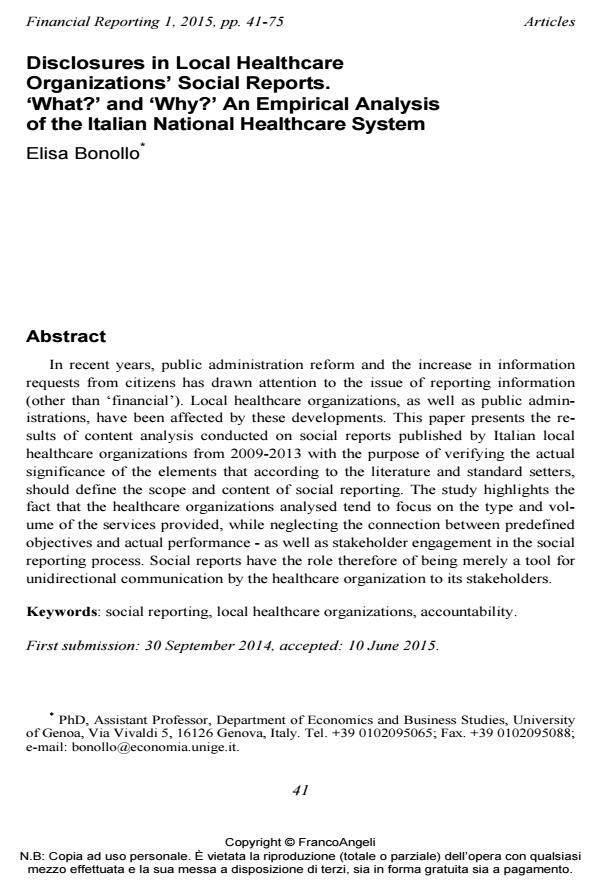Disclosures in Local Healthcare Organizations’ Social Reports. ‘What?’ and ‘Why?’ An Empirical Analysis of the Italian National Healthcare System
Titolo Rivista FINANCIAL REPORTING
Autori/Curatori Elisa Bonollo
Anno di pubblicazione 2015 Fascicolo 2015/1
Lingua Italiano Numero pagine 35 P. 41-75 Dimensione file 495 KB
DOI 10.3280/FR2015-001003
Il DOI è il codice a barre della proprietà intellettuale: per saperne di più
clicca qui
Qui sotto puoi vedere in anteprima la prima pagina di questo articolo.
Se questo articolo ti interessa, lo puoi acquistare (e scaricare in formato pdf) seguendo le facili indicazioni per acquistare il download credit. Acquista Download Credits per scaricare questo Articolo in formato PDF

FrancoAngeli è membro della Publishers International Linking Association, Inc (PILA)associazione indipendente e non profit per facilitare (attraverso i servizi tecnologici implementati da CrossRef.org) l’accesso degli studiosi ai contenuti digitali nelle pubblicazioni professionali e scientifiche
In recent years, public administration reform and the increase in information requests from citizens has drawn attention to the issue of reporting information (other than ‘financial’). Local healthcare organizations, as well as public administrations, have been affected by these developments. This paper presents the results of content analysis conducted on social reports published by Italian local healthcare organizations from 2009-2013 with the purpose of verifying the actual significance of the elements that according to the literature and standard setters, should define the scope and content of social reporting. The study highlights the fact that the healthcare organizations analysed tend to focus on the type and volume of the services provided, while neglecting the connection between predefined objectives and actual performance - as well as stakeholder engagement in the social reporting process. Social reports have the role therefore of being merely a tool for unidirectional communication by the healthcare organization to its stakeholders.
Parole chiave:Social reporting, local healthcare organizations, accountability
- Sustainable development practices in healthcare: a systematic review Luca Del Bene, Giulia Leoni, Carlo Vermiglio, Vincenzo Zarone, in Journal of Health Organization and Management /2025 pp.991
DOI: 10.1108/JHOM-06-2024-0224 - Accounting to ensure healthy lives: critical perspective from the Italian National Healthcare System Simone Pizzi, Fabio Caputo, Andrea Venturelli, in Corporate Governance: The International Journal of Business in Society /2020 pp.445
DOI: 10.1108/CG-03-2019-0109 - Exploring online sustainability disclosure in the healthcare industry: Evidence from best international hospitals Antonello Garzoni, Vitiana L'Abate, Nicola Raimo, Filippo Vitolla, in Business Strategy and the Environment /2024 pp.2669
DOI: 10.1002/bse.3625 - Exploring ESG Disclosure: What? And Why? A Study of Leading European Public Hospitals Katarzyna Wójtowicz, Jan Wójtowicz, in Journal of Finance and Financial Law /2024 pp.139
DOI: 10.18778/2391-6478.3.43.08
Elisa Bonollo, Disclosures in Local Healthcare Organizations’ Social Reports. ‘What?’ and ‘Why?’ An Empirical Analysis of the Italian National Healthcare System in "FINANCIAL REPORTING" 1/2015, pp 41-75, DOI: 10.3280/FR2015-001003